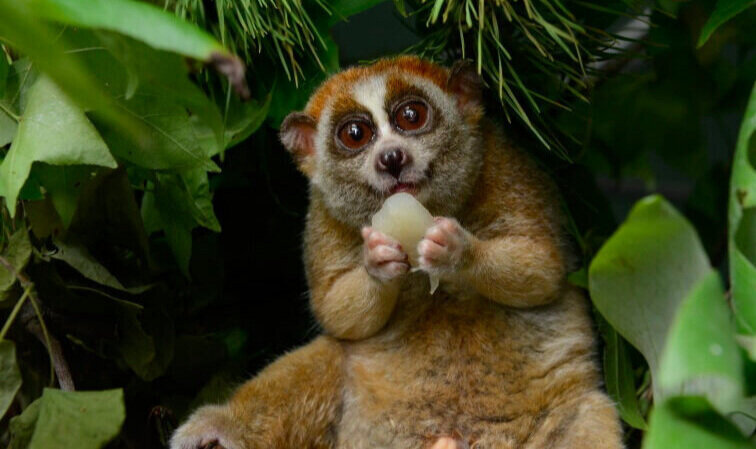Read the Brief Below
The slow loris is preyed upon by pythons, hawk-eagles and what?
Where do they live?
Slow lorises are difficult to detect. It lives in bamboo forest mixed with hardwood trees and dense scrub. Its specialized dentition allows it to gouge trees to induce the flow of gums and sap for food. Though surrounded by leaves, they don’t eat them, but occasionally lick them for moisture.
Winter break
These animals are nocturnal, holing up by day in hollowed-out trees, tree crevices, or branches. They usually curl up in a ball, with their heads tucked up under their arms, making them blend in and stay toasty. When darkness falls they move fluidly both on top or below a branch. They can move quickly if alarmed, or when snatching an insect out of the air. But they don’t jump or leap to another branch.
Fine dinning
The pygmy slow loris eats different types of plants, animal matter, fruits and gums make up more than half of the diet, and insects and small prey items make up another 30 percent. Using its acute sense of smell, lorises effectively hunt and dine in the dark. If a hapless insect goes by, the loris swiftly snatches it out of the air with both hands.
Poisonnous bite!
The loris produces a secretion from glands on the insides of its elbows, which, when mixed with its saliva, serves to venomize its bite. Female lorises sometimes “park” their youngsters while they feed, so they whip up the toxic elixir and lick the little one’s fur to deter predators. Better than a babysitter!
I am not a pet!
With those big, round night vision eyes, small dark ears, a wet nose, fluffy russet coat with snappy white accents, and plump little gripping digits, the pygmy slow loris is likely the most adorable creature you’ll never see in the wild. No matter how adorable the little animals are! I am not a pet!
Big Eyes
The first thing you notice on a slow loris is its huge, round eyes. As a nocturnal hunter and forager, it needs those big eyes to detect its next meal. Packed with retinal rods in its forward-facing eyes, it has sharp depth perception, even among the dim trees. Also enhancing its night vision is a reflective layer of tissue you may recognize it as eyeshine.
Big threats to a little primate.
The pygmy slow loris is also preyed upon by pythons, hawk-eagles and humans. But they don’t take threats lying down! The first line of defense is a fierce hiss and emitting a strong, don’t-eat-me odor. If it’s still under siege, the loris clasps its arms over its head, a pose that, combined with its facial markings, mimics the expanded hood of an angry cobra.







